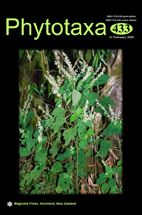Abstract
A new Asteraceae species, Aster huangpingensis W. P. Li & Z. Li from Guizhou, China, is described and illustrated based on morphological and molecular analyses. Detailed morphological comparisons indicated that A. huangpingensis is similar to A. dolichophyllus. However, it can be distinguished from A. dolichophyllus by its lower leaves (2.5) 3.3–5.8 (7.5) × 0.3–0.9 cm, narrowly oblanceolate or spatulate, bracts glandular, punctate, few or absent, involucres campanulate, 3.5–5.5 mm in diam., ray florets 11–22 and disk florets 16–28, middle phyllary margins with strigillose and eglandular hairs, stigmatic appendage equilaterally triangle-shaped, and different flowering period. Molecular analyses based on nuclear ITS and ETS sequence data supported A. huangpingensis as a distinct species, and its systematic position is determined in A. subgen. Aster sect. Aster. Cytological observations showed that the new species is diploid with its karyotype being 2n =2x =18 = 16 m + 2 sm. Its only population is located on riverbanks of a stream that will become a tourist hotspot and is in urgent need for conservation actions.

